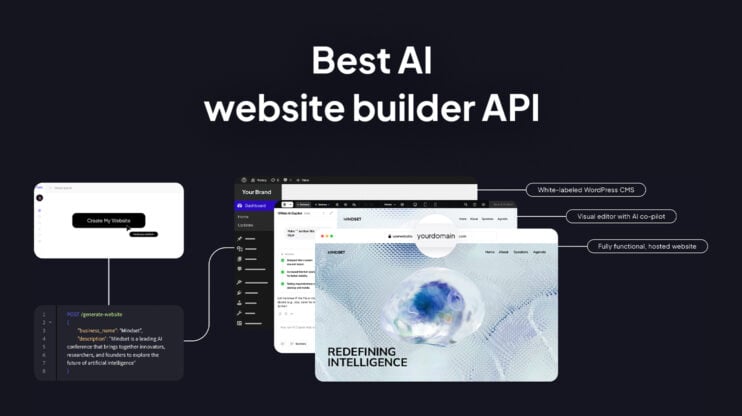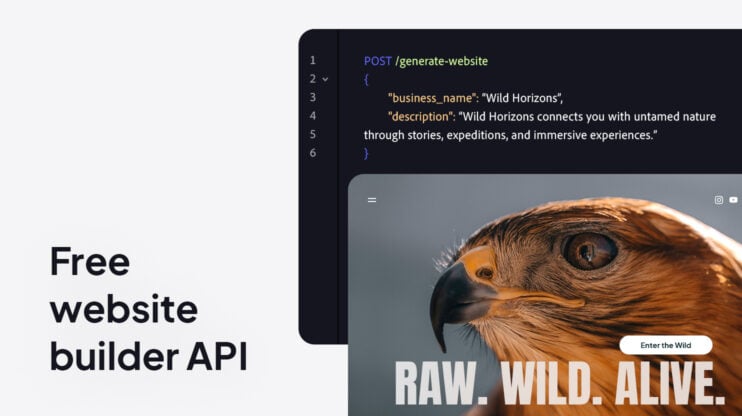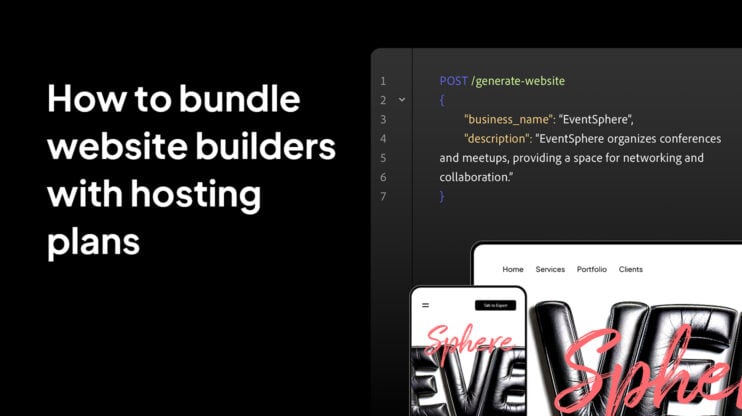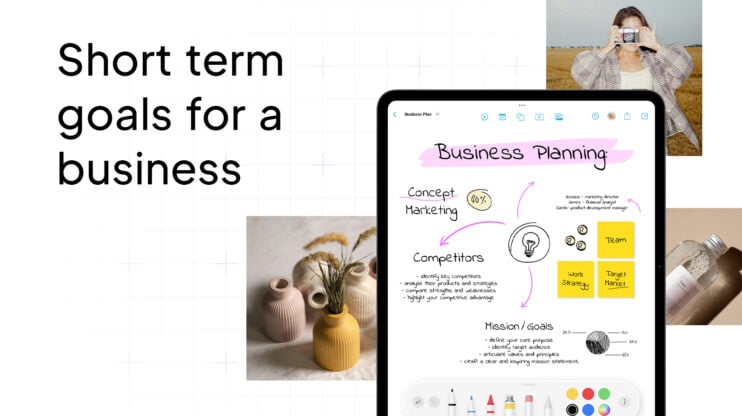If you run an agency, hosting company, or SaaS platform, Webflow is probably already on your radar. It’s a polished visual builder with solid hosting, a capable CMS, and a strong reputation among designers.
But if your long-term plan goes beyond “we build a few marketing sites” and leans more toward selling website + hosting + AI as a branded product, staying in or moving into the WordPress ecosystem for plugins, WooCommerce, and SEO, and eventually embedding a website builder directly into your own app or control panel, you’re dealing with a different kind of challenge than Webflow was originally built to solve. That’s where 10Web starts to look like a serious alternative.
This article doesn’t try to declare a winner. Instead, it’s here to help you figure out which stack actually matches your business model: Webflow’s designer-first, closed platform, or 10Web’s AI-first, white-label, WordPress-based platform.
What Webflow offers
Webflow is fundamentally a visual front-end platform. It’s built for teams that care about pixel-level control over layout, interactions, and animation, without relying heavily on developers.
In practice, Webflow gives you:
- A powerful Designer + CMS for marketing and content-driven sites using a canvas-style interface
- Managed hosting with SSL, CDN, and strong uptime, so you don’t deal with servers or deployments
- A CMS/Data API to manage and deliver content programmatically
- A layered pricing model (site plans + workspace plans) tuned for freelancers, agencies, and in-house teams
There is some white-labeling: on certain workspace tiers, you can replace Webflow’s logo in the legacy Editor to make things look more on-brand for clients. But you’re not running a fully white-labeled platform with your own dashboard, billing, and system emails. Webflow is still very visibly Webflow.
If your primary concern is designing high-quality marketing sites quickly, and you’re fine with Webflow as the visible platform, this can be a great fit.
What 10Web brings to the table
10Web comes at this from a different direction: how do we let partners offer an AI-powered website + hosting service under their own brand, without giving up WordPress?
In practice, that shows up in a few core pillars. 10Web gives you:
- AI website generation on WordPress: The AI builder generates full WordPress sites (including WooCommerce stores) from a business description: structure, pages, content, and images.
- A white-label reseller platform: You operate from a reseller dashboard on your own domain, branded as your platform. You create and manage client sites, define and price your own plans, control access with roles and permissions, and send branded invoices and system emails. To clients, it’s your platform, not 10Web’s.
- Managed WordPress hosting and operations: 10Web handles hosting, SSL, performance optimization, backups, and security for WordPress.
- Website Builder API and integration options: For more advanced partners (hosts, SaaS products, telcos), 10Web provides an API and self-hosted plugin options. You can trigger AI site generation from inside your own app, provision WordPress sites, domains, and SSL automatically, enforce plugin and template policies globally, and keep the entire UX inside your own product.
Throughout all of this, everything is still WordPress. You keep access to plugins, WooCommerce, and SEO tooling, while presenting a modern, SaaS-like experience to customers under your own brand.

Your Brand. Their Website. Done.
Launch websites fast, with ongoing revenue built in. 10Web’s white-label AI Website Builder lets your agency scale without extra dev time.
Core features and functionalities
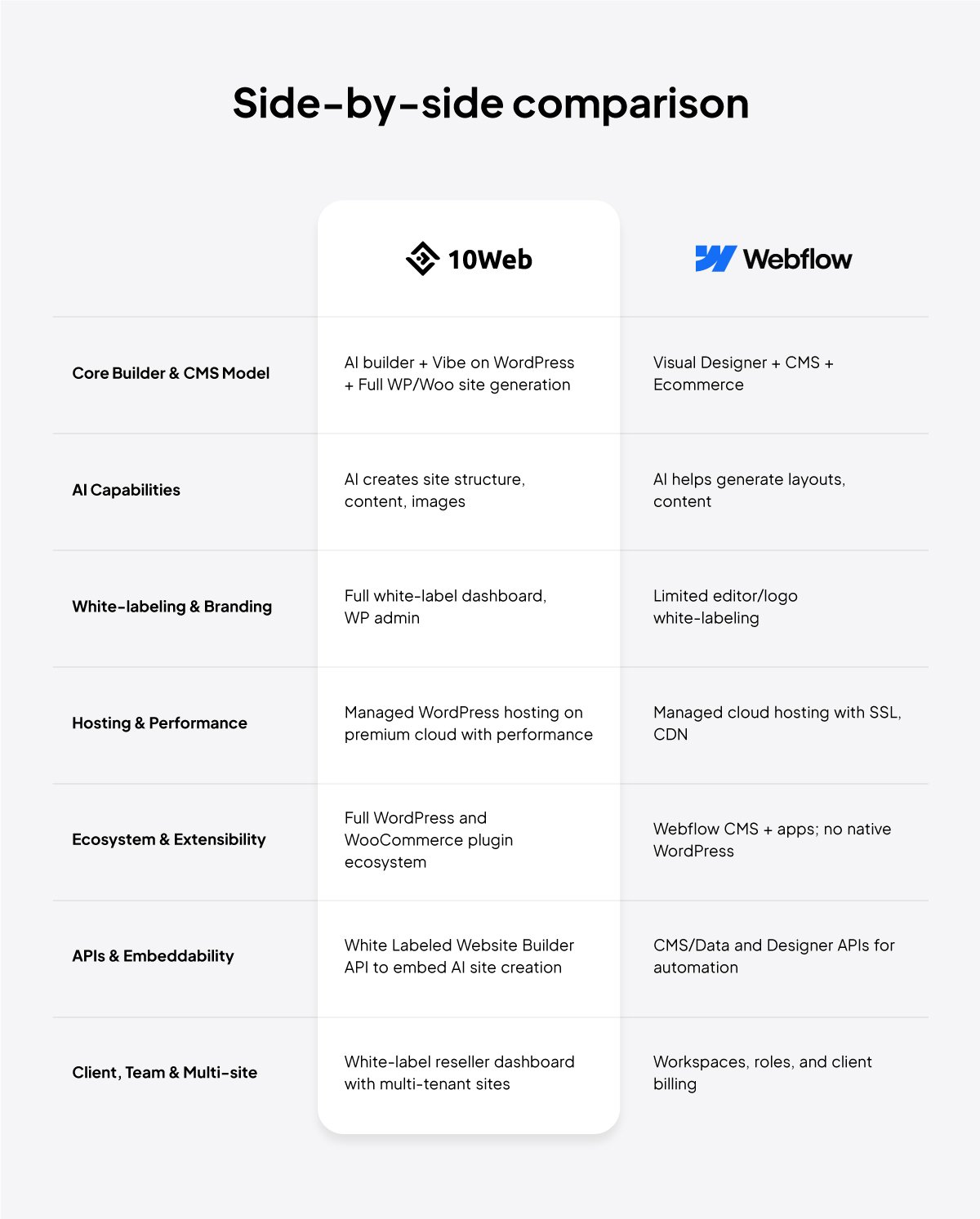
The differences that matter
On the surface, 10Web and Webflow are both builders, but they’re different kinds of platforms. Webflow is a branded SaaS: you can add your logo in some editor views, but it stays a closed Webflow environment. 10Web treats you as the platform, with your domain, fully white-labeled dashboard and WordPress admin, plus the full WP ecosystem of plugins, WooCommerce, and extensions.
With Webflow, you’re essentially saying, “we build sites using Webflow.” With 10Web, you’re selling “website + hosting + AI” as your product. Its Website Builder API lets you embed “Create website” directly in your own app, while 10Web spins up the AI-generated WordPress site with hosting and SSL in the background and you stay in control of pricing, UX, and billing.
When 10Web is likely the better fit
You’ll probably lean toward 10Web if your plan looks less like one-off web design projects and more like running a platform of your own. In practice, that usually shows up in a couple of ways:
- You want to sell websites + hosting + AI under your own brand, not just build sites on a third-party tool.
- You need WordPress/WooCommerce flexibility at scale and don’t want to be locked into a closed ecosystem.
If this is you, then you’re on your way to defining the backbone of a recurring-revenue product. 10Web gives you the stack to package AI site creation, managed hosting, and WordPress into something that feels like your platform, with room to layer on plugins, custom flows, and upsells over time. In other words, if you’re thinking like a platform operator more than a design studio, 10Web tends to align much better with where you’re heading.
Where Webflow makes more sense
Webflow is still a very strong choice in many scenarios. You’ll probably lean toward Webflow if your world is more about design craft and shipping polished marketing sites than about running a white-label platform. In practice, that usually looks like this:
- You’re a design-led agency or in-house marketing team focused on high-end marketing sites, landing pages, and product storytelling, and you value Webflow’s visual control and designer-friendly workflows.
- You don’t plan to sell “website + hosting” as your own platform and would rather avoid WordPress entirely than manage plugins, themes, and a WP-based stack.
If your goal is to give designers a powerful visual tool, keep the stack simple, and deliver standout sites without building a branded SaaS-style platform around them, Webflow often feels like the most straightforward option.
A quick decision checklist
- Clarify your business model: If you do mostly custom, one-off projects, either tool works. If you want to sell website + hosting + AI as your own product, 10Web fits better.
- Decide whether you want WordPress: If you don’t want WordPress or plugins at all, Webflow is simpler. If you do want WP plugins, WooCommerce, or SEO tools, start with 10Web.
- Set your white-label depth: If light editor branding is enough, Webflow can work. If you need your own dashboard, billing, domains, and emails under your brand, choose 10Web.
- Estimate your volume: If you launch only a few sites a year, choose based on design preference. If you expect dozens or hundreds, 10Web’s AI and API-led reseller stack scales better.
Final thoughts
10Web and Webflow are both strong, but they’re built for different futures. Webflow is a designer-first, closed SaaS builder—great if you care most about visual control and don’t need deep white-labeling or WordPress.
10Web is an AI-native, WordPress-based, white-label platform you can resell, bundle with hosting, and embed into your own product. If you want AI speed, operate in a WordPress world, and plan to sell “website + hosting” as your own platform, 10Web is likely the better fit; if your goal is simply to give designers the best visual builder for bespoke marketing sites, Webflow remains an excellent choice.

Your Brand. Their Website. Done.
Launch websites fast, with ongoing revenue built in. 10Web’s white-label AI Website Builder lets your agency scale without extra dev time.
FAQ
How does 10Web’s white-label work in practice?
With 10Web, you put the whole experience under your domain and brand: the dashboard, WordPress admin, client login, plans, billing, and system emails. Clients don’t see 10Web; they see your platform providing websites and hosting. This is different from logo-level branding in an editor—you’re effectively running your own SaaS.
Who is 10Web built for?
10Web is built for agencies, MSPs, hosts, and SaaS products that want to:
- Sell website + hosting + AI as their own recurring product
- Stay in the WordPress/WooCommerce ecosystem
- Manage many client sites from one place
- Eventually embed website creation into their own app or control panel
If you think in terms of platforms, subscriptions, and MRR rather than just projects, you’re the target.
How does 10Web help if I already work with WordPress?
10Web keeps everything on WordPress, but wraps it in an AI-first, managed, and white-labeled layer. You still get plugins, WooCommerce, and familiar WP workflows, but you don’t manage servers, performance tuning, or scattered tools. Instead, you provision sites, apply policies, and manage clients from a single branded dashboard.
Can I move from Webflow (or another builder) to 10Web?
You can rebuild or regenerate sites on WordPress using 10Web’s AI builder and then standardize on templates, plugins, and flows inside the 10Web platform. If your long-term plan is WordPress plus recurring hosting revenue under your brand, migrating earlier usually means less future rework.
How does pricing work on 10Web’s side vs what I charge clients?
On the 10Web side, you’re on a partner/reseller arrangement that bundles AI building, managed WP hosting, and the white-label stack.
On your side, you’re free to define your own plans and margins. For example, Starter Website + Hosting, Business Site + Care Plan, or AI Website + Store. 10Web is the engine; your catalog and pricing sit on top.







